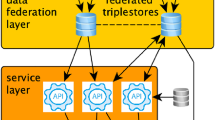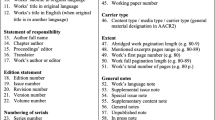Abstract
The advent of large-scale citation indexes has greatly impacted the retrieval of scientific information in several domains of research. The humanities have largely remained outside of this shift, despite their increasing reliance on digital means for information seeking. Given that publications in the humanities have a longer than average life-span, mainly due to the importance of monographs for the field, this article proposes to use domain-specific reference monographs to bootstrap the enrichment of library catalogs with citation data. Reference monographs are works considered to be of particular importance in a research library setting, and likely to possess characteristic citation patterns. The article shows how to select a corpus of reference monographs, and proposes a pipeline to extract the network of publications they refer to. Results using a set of reference monographs in the domain of the history of Venice show that only 7% of extracted citations are made to publications already within the initial seed. Furthermore, the resulting citation network suggests the presence of a core set of works in the domain, cited more frequently than average.






Similar content being viewed by others
Notes
Using the Brat annotation environment available at http://brat.nlplab.org/. Cf. Stenetorp et al. [26].
The last version is detailed in SBN [25].
The full list of features is available upon request.
The annotators use the online search interface of the library catalog to retrieve the BIDs. The search interface is available at http://www.sbn.it/opacsbn/opac/iccu/free.jsp.
References
Ahlgren, P., Pagin, P., Persson, O., Svedberg, M.: Bibliometric analysis of two subdomains in philosophy: free will and sorites. Scientometrics 103, 47–73 (2015)
Ardanuy, J.: Sixty years of citation analysis studies in the humanities (1951–2010). J. Am. Soc. Inf. Sci. Technol. 64(8), 1751–1755 (2013)
Barrett, A.: The information-seeking habits of graduate student researchers in the humanities. J. Acad. Librariansh. 31(4), 324–331 (2005)
Buchanan, G., Cunningham, S.J., Blandford, A., Rimmer, J., Warwick, C.: Information seeking by humanities scholars. In: International Conference on Theory and Practice of Digital Libraries. Springer, pp. 218–229 (2005)
Councill, I.G., Giles, C.L., Kan, M.Y.: ParsCit: an open-source CRF Reference String Parsing Package. In: LREC (2008)
Hammarfelt, B.: Interdisciplinarity and the intellectual base of literature studies: citation analysis of highly cited monographs. Scientometrics 86(3), 705–725 (2011)
Hammarfelt, B.: Using altmetrics for assessing research impact in the humanities. Scientometrics 101(2), 1419–1430 (2014)
Heinzkill, R.: Characteristics of references in selected scholarly English literary journals. Libr. Q. 50(3), 352–365 (1980)
Heinzkill, R.: References in scholarly English and American literary journals thirty years later: a citation study. Coll. Res. Libr. 68(2), 141–154 (2007)
Kellsey, C., Knievel, J.: Overlap between humanities faculty citation and library monograph collections, 2004–2009. Coll. Res. Libr. 73(6), 569–583 (2012)
Kim, Y.M., Bellot, P., Faath, E., Dacos, M.: Automatic annotation of bibliographical references in digital humanities books, articles and blogs. In: Proceedings of the 4th ACM workshop on Online books, complementary social media and crowdsourcing, ACM, pp. 41–48 (2011)
Knievel, J.E., Kellsey, C.: Citation analysis for collection development: a comparative study of eight humanities fields. Libr. Q. Inf. Community Policy 75(2), 142–168 (2005)
Lafferty, J., McCallum, A., Pereira, F.: Conditional random fields: probabilistic models for segmenting and labeling sequence data. In: Proceedings of ICML, pp. 282–289 (2001)
LindholmRomantschuk, Y., Warner, J.: The role of monographs in scholarly communication: an empirical study of philosophy, sociology and economics. J. Doc. 52(4), 389–404 (1996)
Linmans, A.J.M.: Why with bibliometrics the Humanities does not need to be the weakest link: indicators for research evaluation based on citations, library holdings, and productivity measures. Scientometrics 83(2), 337–354 (2009)
Lopez, P.: GROBID: combining automatic bibliographic data recognition and term extraction for scholarship publications. In: Research and Advanced Technology for Digital Libraries, Springer, pp. 473–474 (2009)
Marchi, M.D., Lorenzetti, E.: Measuring the impact of scholarly journals in the humanities field. Scientometrics 106(1), 253–261 (2015)
McCain, K.W.: Citation patterns in the history of technology. Libr. Inf. Sci. Res. 9, 41–59 (1987)
Mingers, J., Leydesdorff, L.: A review of theory and practice in scientometrics. Eur. J. Oper. Res. 246(1), 1–19 (2015)
Mongeon, P., Paul-Hus, A.: The journal coverage of Web of Science and Scopus: a comparative analysis. Scientometrics 106(1), 213–228 (2015)
Nederhof, A.J.: Bibliometric monitoring of research performance in the social sciences and the humanities: a review. Scientometrics 66(1), 81–100 (2006)
Nolen, D.S., Richardson, H.A.: The search for landmark works in English literary studies: a citation analysis. J. Acad. Libr. 42(4), 453–458 (2016)
Okazaki N (2007) CRFsuite: a fast implementation of Conditional Random Fields (CRFs). www.chokkan.org/software/crfsuite
Romanello, M., Colavizza, G.: dhlab-epfl/LinkedBooksMonographs: LinkedBooksMonographs (version 1.0) (2017). doi:10.5281/zenodo.266889
SBN, G.: Reicat—GuidaSBN (2016). http://norme.iccu.sbn.it/index.php?title=Reicat&oldid=3034. Last Accessed 9 Jan 2017
Stenetorp, P., Pyysalo, S., Topić, G., Ohta, T., Ananiadou, S., Tsujii, J.: BRAT: a web-based Tool for NLP-assisted text annotation. In: Proceedings of the Demonstrations at the 13th Conference of the European Chapter of the Association for Computational Linguistics, Association for Computational Linguistics, EACL ’12, pp. 102–107 (2012)
Sula, C.A., Miller, M.: Citations, contexts, and humanistic discourse: toward automatic extraction and classification. Lit. Linguist. Comput. 29(3), 452–464 (2014)
Thelwall, M., Delgado, M.M.: Arts and humanities research evaluation: no metrics please just data. J. Doc. 71(4), 817–833 (2015)
Thompson, J.W.: The death of the scholarly monograph in the humanities? Citation patterns in literary scholarship. Libri 52(3), 121–136 (2002)
Waltman, L.: A review of the literature on citation impact indicators. J. Informetr. 10(2), 365–391 (2016)
Weingart, S.B.: Finding the history and philosophy of science. Erkenntnis 80(1), 201–213 (2015)
Wiberley, Jr S.E.: Humanities literatures and their users. In: Encyclopedia of Library and Information Sciences, pp. 2197–2204 (2010)
Williams, P., Stevenson, I., Nicholas, D., Watkinson, A., Rowlands, I.: The role and future of the monograph in arts and humanities research. Aslib Proc. 61(1), 67–82 (2009)
Wu, J., Williams, K., Chen, H.H., Khabsa, M., Caragea, C., Ororbia, A., Jordan, D., Giles, C.L.: Citeseerx: Ai in a digital library search engine. In: Innovative Applications of AI Conference (2014)
Zordan, G.: Repertorio di storiografia veneziana: testi e studi. Il Poligrafo, Padova (1998)
Zuccala, A., Guns, R., Cornacchia, R., Bod, R.: Can we rank scholarly book publishers? A bibliometric experiment with the field of history. J. Assoc. Inf. Sci. Technol. 66(7), 1333–1347 (2014)
Acknowledgements
We thank Martina Babetto and Silvia Ferronato for the digitization and annotation of the dataset. The Library of the Ca’ Foscari University of Venice willingly collaborated with bibliographical resources and logistics support. The Central Institute for the Union Catalogue of Italian Libraries and Bibliographic Information (ICCU) shared its catalog metadata with us. We thank both for their support. Finally, we thank our anonymous reviewers for their helpful comments. This project is funded by the Swiss National Fund under Division II, project number 205121_159961. Colavizza also benefits from a separate Swiss National Fund grant, number P1ELP2_168489.
Author information
Authors and Affiliations
Corresponding author
Rights and permissions
About this article
Cite this article
Colavizza, G., Romanello, M. & Kaplan, F. The references of references: a method to enrich humanities library catalogs with citation data. Int J Digit Libr 19, 151–161 (2018). https://doi.org/10.1007/s00799-017-0210-1
Received:
Revised:
Accepted:
Published:
Issue Date:
DOI: https://doi.org/10.1007/s00799-017-0210-1




